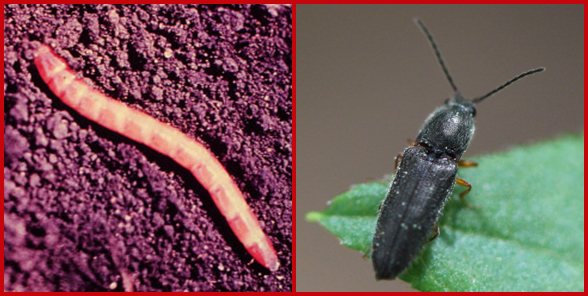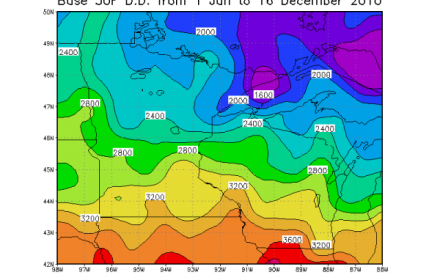Authors: David Lowenstein and Russell Groves, UW-Madison Entomology
Last Revised: 05/22/2020
X-number: XHT1045
Wireworms are the larvae of several species of click beetles (Family Elateridae). These beetles flip into the air with an audible click when turned on their backs. Wireworms feed primarily on grasses (including grass crops such as corn) but have a broad host range that includes vegetables (e.g., beans, beets, cabbage, carrots, lettuce, onion, peas, potatoes and radishes) and herbaceous ornamentals. Wireworms can be found virtually anywhere, and they are very common in old fields or grass pastures, which are attractive egg-laying sites for female click beetles. Wireworms tend to cause their most significant damage in poorly drained areas, particularly if sod has been plowed under within the past one to four years.

Appearance: Wireworms are thin, shiny, jointed, yellow to reddish-brown, worm-like larvae resembling mealworms. They range in length from 1/4 to 11/2 inches and are approximately 1/8 inch wide. Different species are distinguished by the ornamentation on the last segment of their bodies. Adult wireworms (click beetles) are hard-shelled, brown or black, “streamlined” beetles that make a clicking sound when they right themselves after being overturned.
Symptoms and Effects: Adult wireworms (click beetles) do not cause plant damage. However, larvae can feed on seeds and developing seedlings, as well as on the roots and underground stems of older plants. Damage often occurs in localized areas in a planting. Seed feeding prevents or delays germination. Seedling feeding (often characterized by the presence of small holes in cotyledons and stems) can stunt or kill plants. Seed/seedling feeding typically leads to uneven and reduced stands. Wireworm feeding on smaller roots of older plants leads to stunted roots with brown discolorations. Feeding on larger roots and underground stems leads to visible trails or small tunnels. Root and underground stem damage can lead to stunted growth and wilting above ground, particularly if plants are small or under stress (e.g., water stress). Wireworms can be particularly problematic on potatoes where they burrow into tubers, making the tubers unusable.
Life Cycle:
Wireworms have an extended life cycle, taking from one to six years to complete a single generation. They can overwinter as either adults or larvae. Adults emerge in the spring. Females spend most of their 10 to 12 month life span in the soil laying eggs (up to 100 eggs per female), usually in grassy, weedy areas in gardens and fields. Eggs hatch over a period of several days to several weeks depending on the temperature. Larvae move short distances to feed on seeds and roots. They prefer moist, cool, heavy soils and typically live in the upper six inches of the soil. However, during dry weather, they may burrow deeper. Because of their extended life cycle, larvae of some species of wireworms will feed for up to six years before pupating. Adults emerge the spring after the pupae form.
Scouting Suggestions:
No thresholds for wireworms have been identified, so routine scouting is not recommended. However, watch for wireworms in the soil when you till your home garden. Also check for larvae near ungerminated seeds, in the roots and lower stems of damaged plants and in the upper four to six inches of soil in any suspect area.
Alternatively, if you are a commercial vegetable grower, you can monitor for wireworms using bait stations that you can set up in the fall or spring. Use at least ten bait stations per 40 acre field to obtain an accurate estimate of the number of wireworms in an area. For each station, prepare bait by soaking approximately one cup each of untreated corn and wheat seed in water for 24 hours to encourage germination. At each bait station, place seeds into a six inch deep hole that is several inches wide. Cover the seeds with soil, then with a small piece of black plastic, and then with a securely anchored piece of clear plastic. The plastic will help the sun heat the soil, speeding seed germination. The germinating seed will attract wireworms from the surrounding soil. Check the bait stations after one week by digging up the germinating seeds and counting the number of wireworms in with the seeds. Consider chemical control if there is an average of one or more wireworm per station.
Control
Non-Chemical: Prior to planting, improve drainage in those areas where the soil drains poorly. Rotate crops appropriately (see University of Wisconsin Garden Facts Using Crop Rotation in the Home Vegetable Garden for details) and avoid growing vegetables that are especially susceptible to wireworm damage, particularly in areas where wireworms have been a problem in the past. DO NOT plant too early into cold soils. Instead, plant later when soils are warmer. Late planting will speed germination, allow plants to establish quickly and reduce the amount of time that plants are in the early stages of growth where wireworms can cause more severe damage. Be diligent about controlling weeds in areas where you are growing your vegetables, and also consider not growing crops for a summer (while still keeping weeds under control) in areas where wireworms have been a serious problem.
Chemical: Because severe outbreaks of wireworms are rare, insecticide use typically is not warranted. If you have had a history of wireworm problems and believe that treatments are needed, incorporate insecticides into the soil prior to planting. DO NOT apply insecticides once you have observed wireworm damage, as treatments at that point are typically not effective. For a complete listing of products for wireworm control, see Commercial Vegetable Production in Wisconsin (2024).
Download Article





 Centipedes
Centipedes Using Crop Rotation in Home Vegetable Garden
Using Crop Rotation in Home Vegetable Garden Degree Days for Common Fruit & Vegetable Insect Pests
Degree Days for Common Fruit & Vegetable Insect Pests Calculating Degree Days
Calculating Degree Days


